I’d been away from official chess competition for over 20 years, when I walked into the Chess Palace, in Lakewood, California, in the spring of 1993, to play in a three-round one-day tournament. There’s no consulting a chess book when you’re over the board, especially not in a rated game. Those countless chess facts, remembered or forgotten, had to remain at home in those books, as I sat down to my first game. I had White against Rick Young, who had a rating of 1593. Here’s how the opening progressed in a Caro Kann Defense.
1) e4 c6
2) d4 d5
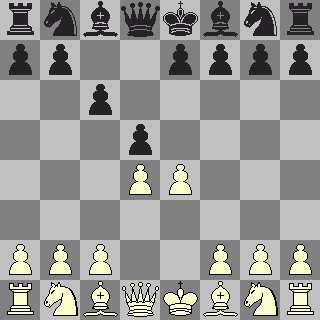
Diagram-1 White has a number of third-move choices in the Caro Kann
I was probably ill prepared for this opening.
3) e5 Bf5
4) f4 . . . . not a standard move here. Nf3 or Nc3 would probably have been better.
4) . . . . e6
5) Nf3 c5 striking at the base of the pawn chain, according to standard theory.
6) c3 cxd4
7) Nxd4 Ne7
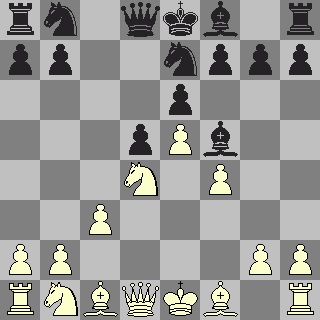
Diagram-2 after Black’s Ne7
Two decades after I played this game with Mr. Young, I now suspect I should have put pressure on my opponent with Bb5+. I probably thought of that move but saw that Black would appear safe after Nb8c6, for if I then played Qa4, Black would defend with the queen. Still, it could have tied up some of Black’s pieces, at least for awhile.
8) Nd2 Nb8c6
9) Nd2f3 a6
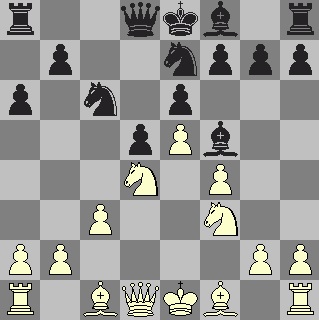
Diagram-3 after Black moved a6
Now Bb5 is not available. At this point, I saw no reasonable way to avoid trading away my good bishop. After all these years, as I look at this position, I still don’t see much future in my light-squared bishop unless I capture the f5 bishop before moving Bd3. In this unusual variation of the Caro Kann (with f4), that black bishop at f5 may have more access to e4, in the middle game, than it otherwise would have. In this game, it never got to that point.
In 1993, I wanted to keep at least one of my knights, to keep using that outpost on d4. It now seems obvious: Black will have the opportunity to trade away all the knights, if he chooses, so that square will probably be of little use to me later on.
As I now see it, I would move 10) Nxf5 and hope that my two bishops will be useful later in the game, even though Black’s knights look like they’ll have good squares. One advantage of having two bishops and a knight against two knights and one bishop is this: You may have more choices regarding trading a bishop for a knight than your opponent has of trading a knight for a bishop.
10) Bd3 Nxd4
11) Nxd4 Bxd3
12) Qxd3 . . . .
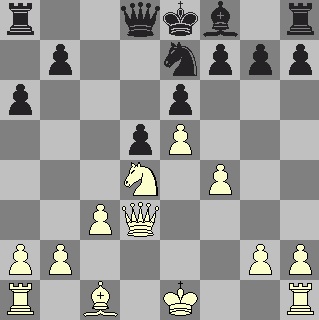
Diagram-4
Let’s now skip ahead to the endgame, for I made two mistakes, costing me the game.
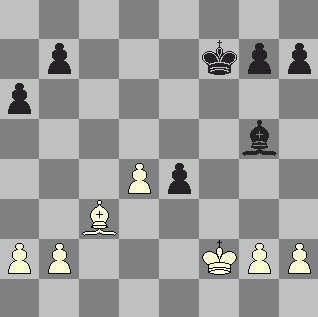
Diagram-5 after Black’s 28) Bg5
I now believe that I here made my first endgame mistake in this game. The first question is this: Does Black threaten e3+? Not necessarily. In fact, if my bishop can quickly attack that black pawn, I could win it.
I now believe that I was in a defensive mood at this point in the game, for it’s an obvious concern that Black’s passed pawn is slightly more advanced than mine. Yet look at what may be accomplished with 29) d5. My bishop would then point at the g7 pawn and the black king would have no immediate way to advance towards the center. Look at one potential line, from Diagram-5, if I had moved d5 and my opponent had been rash:
29) d5 e3+ (apparently a mistake)
30) Kf3 g6
31) Bd4 Kd7
32) Bxe3 . . . . and it now the white king will soon reach e4, protecting the d5 pawn
I missed the move 29) d5, however, and soon mismanaged the placement of my king and bishop, losing a pawn and then, after 63 moves, the game.
Let’s look again at Diagram-5, and see another possibility for Black:
29) d5 g6
30) Be5 . . . .
Now White might have the option of pushing the pawn to d6, although that could also be rash. The resulting pawn endgame, should bishops be exchanged, looks like a draw.
###
.
The Backyard Chess Professor of Idaho
I have found the Youtube chess videos of Kerry Shirts . . . to be delightful entertainment and probably helpful to a number of raw beginners . . . His rating with the United States Chess Federation (as of mid-November, 2015) is only 747, not in the top 1,000 players in the state of Idaho . . .
Books can also be divided into ages of readers, from small children to those 10-12 years old to teenagers and adult chess players.
Children, teenagers, and adults can benefit from concentrating on a game of chess, for it’s good mental exercise. For those in school, playing the royal game can improve scholastic performance; yes it has been shown to improvement the brain in ways that can help one’s education.
For a teenager: a new chess book
Whether you’re giving a chess book as a gift or buying it for yourself, comparing these two publications may be helpful.
.



Pingback: Tactics in a Chess Combination | Success in Chess